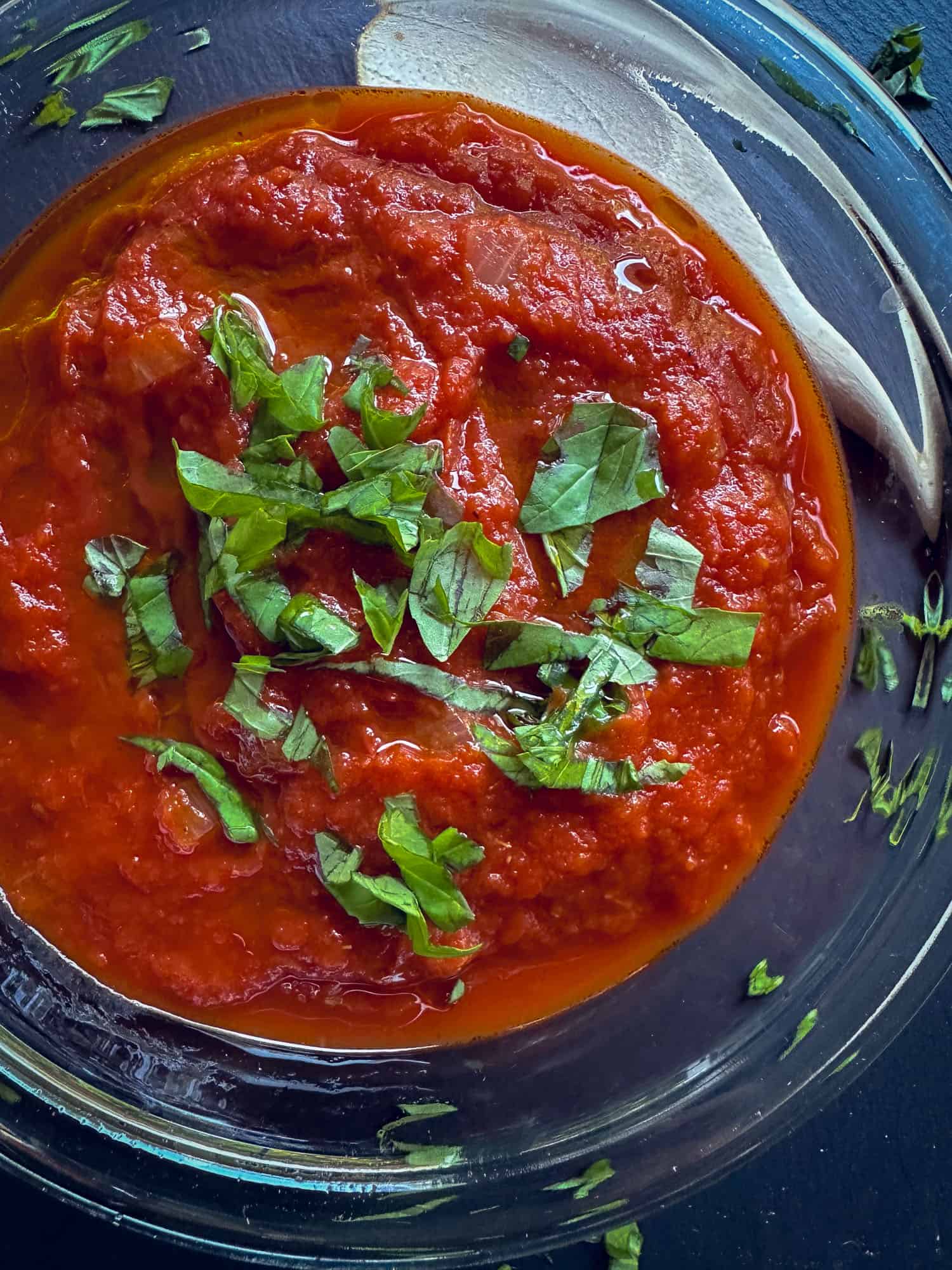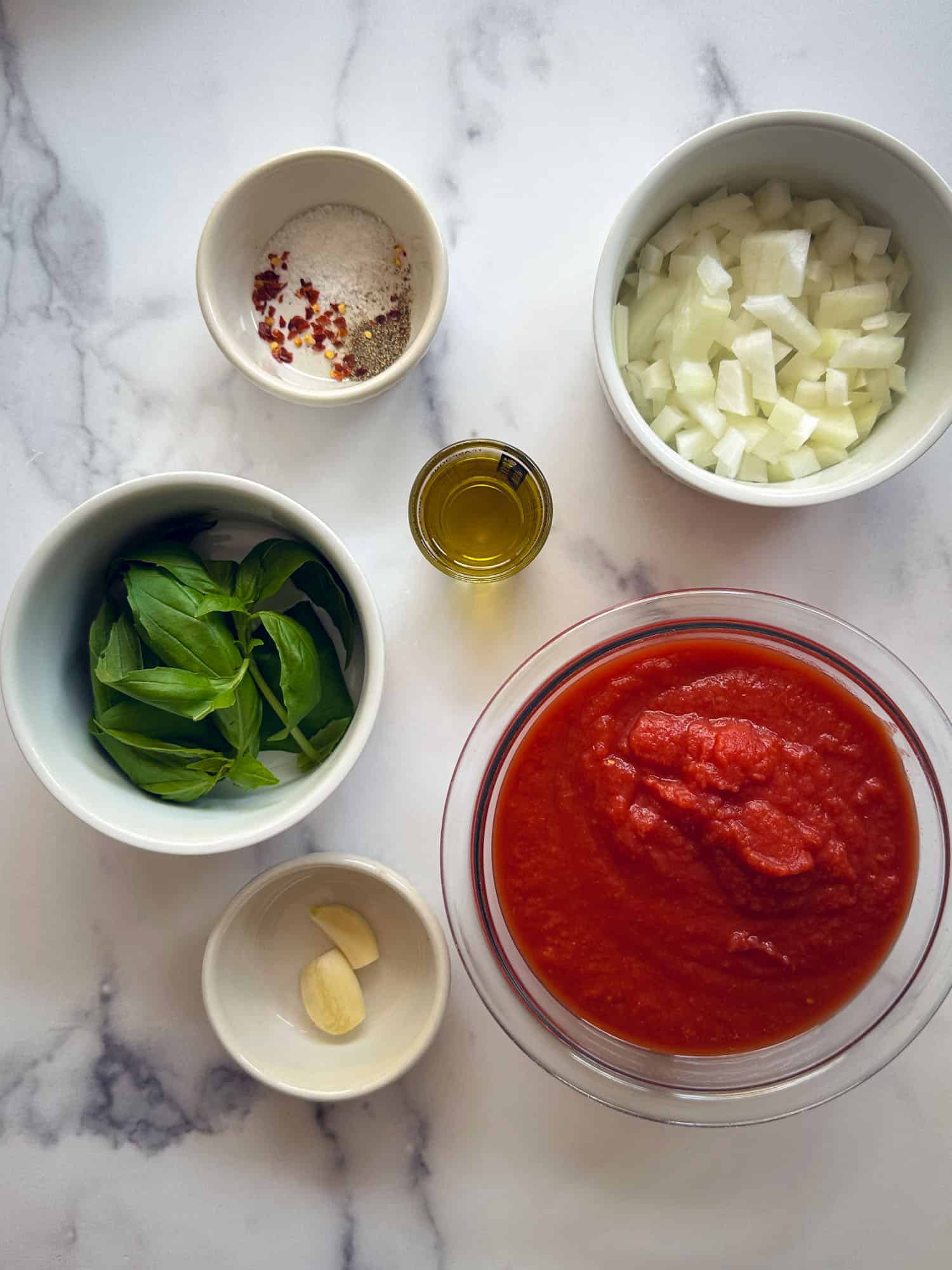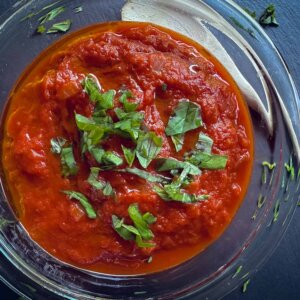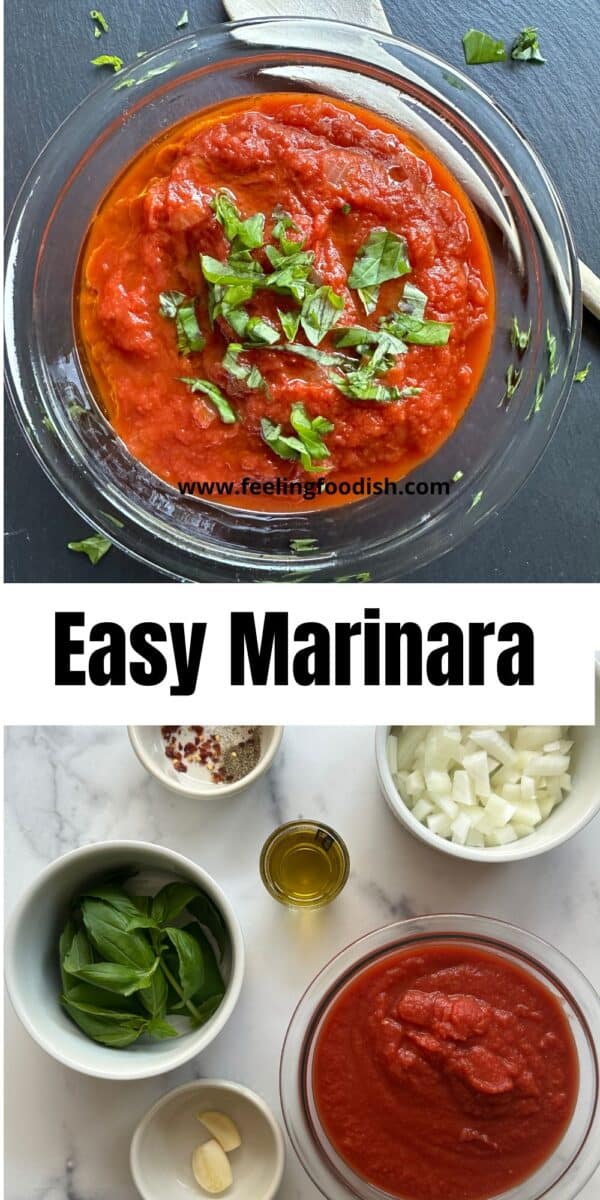The Best Homemade Marinara Sauce
This post may contain affiliate links. For more information, please see our disclosure policy.
This effortless authentic Italian homemade marinara sauce is so simple yet so delicious! It’s one of my favorite sauces to make because it’s just so easy and good!
The depth of flavors includes a touch of sweetness from the tomatoes, aromatics like onion and garlic, and fragrant basil leaves, all brought together with a touch of olive oil and a hint of gentle spiciness from red pepper flakes (or if you want more than a hint, try our Arrabbiata sauce). Simple and just perfect for a quick and delightful pasta night!

Jump to:
Why Homemade is Best!
Marinara sauce is a classic Italian tomato-based sauce that typically consists of tomatoes, onions, garlic, basil, and olive oil. It is known for its simplicity and is often used as a base for various pasta dishes.
There are so many reasons to make your own marinara sauce:
Authentic Italian Flavors: Crafted with canned tomatoes, onion, garlic, and basil, this marinara sauce delivers the true essence of Italian cuisine.
Simple and Quick: With just a handful of fresh, quality ingredients, this flavorful sauce takes only about 20 minutes in cooking time, making it the perfect go-to for busy weeknights when you crave something comforting (but if you want a long and slow cooked tomato sauce try my other favorite!).
Healthier Alternative: By making your own marinara, you have full control over the ingredients, ensuring there are no unnecessary additives, preservatives, or excessive amounts of sugar, salt, or oil, making it much a healthier option than store-bought versions.
Versatility: This sauce is not just for pasta! Use it as a dip for mozzarella sticks, stuffed long hots, spread for grinders, or even a tasty topping for meatballs. The possibilities are endless!
Cost-Effective: Buying fresh ingredients to make your marinara sauce can often be more budget-friendly than purchasing expensive jars or cans from the store. Plus, you can customize it to your liking without spending extra.
What You’ll Need

Olive Oil (Extra Virgin): The olive oil serves as the cooking fat and adds a rich, fruity flavor to the sauce. It also helps to sauté the onions and garlic, infusing the sauce with their delicious aroma. Choose a good-quality extra virgin olive oil for the best flavor. Look for a brand you trust or one with a fruity and smooth taste.
Onion (Chopped or Whole): The onion provides a savory and sweet base for the sauce. If left whole, it can be removed after cooking, but chopping it allows it to fully integrate into the sauce, enhancing its flavor. Opt for a large onion with firm, blemish-free skin. It should feel heavy for its size.
Garlic (Smashed or Minced): Garlic is an aromatic ingredient, adding a wonderful depth of flavor. Smashing the garlic releases its oils, while mincing it intensifies its taste. Select firm, plump garlic bulbs with no soft spots or green shoots.
Crushed Tomatoes (or Tomato Sauce or Puree): The crushed tomatoes form the base of the marinara sauce, providing its main flavor and texture. You can use canned crushed tomatoes or other tomato products like tomato sauce or puree, depending on your preference. When using canned tomatoes or tomato products, read the labels and choose products with minimal additives and preservatives.
Salt: Salt enhances the overall taste of the sauce, bringing out the flavors of the tomatoes, onions, and garlic.
Black Pepper: Black pepper adds a subtle touch of heat and complements the other flavors in the sauce.
Red Pepper Flake: The red pepper flakes provide a mild spiciness, balancing the sweetness of the tomatoes and giving the sauce a slight kick.
Fresh Basil (or Frozen): Basil is the signature herb in marinara sauce, adding a bright, herbal note that perfectly complements the tomatoes. You can use fresh basil leaves, chopped or torn, or opt for frozen basil if fresh is not available. Choose fresh basil leaves that are vibrant green and free from wilting or yellowing. Frozen basil can be a good option if fresh basil is not available, as it still retains much of its flavor. Dried basil unfortunately should not be substituted here.
How to Make the Marinara
Warm the Pan and Sauté the Onion: Begin by placing a medium-sized sauté pan or pot over medium-high heat. Drizzle the olive oil into the pan and wait for it to shimmer. Toss in the chopped onion and sauté for a few minutes until it turns translucent and tender, infusing the kitchen with its savory aroma (approximately 3 minutes).
Infuse with Garlic Aroma: Now, introduce the smashed or minced garlic to the pan and continue heating just until you can smell the garlic – this should only be about 15 seconds or less. Watch the garlic closely to prevent it from burning, allowing its delightful fragrance to mingle with the onions.
Unveil the Marinara’s Essence: Carefully add the crushed tomatoes (or tomato sauce or puree) along with the salt, black pepper, and red pepper flakes to the pan and enough water to slightly thin the sauce. Stir all the ingredients together, ensuring they merge harmoniously to create the essence of the marinara sauce.
Simmer to Perfection: Reduce the heat to low and cover the pan, letting the sauce simmer gently for about 20 minutes. This slow cooking allows the flavors to meld and intensify, transforming the simple ingredients into a rich and delectable marinara sauce.
Tip: For a touch of freshness, you can stir in chopped fresh basil or a handful of frozen basil during the last few minutes of simmering. The basil’s herbal notes will elevate the sauce, infusing it with an authentic Italian charm.
Top Tips
Quality Tomatoes: My top tip is to choose high-quality canned tomatoes or other ripe, flavorful tomatoes for the best results. Good tomatoes are the foundation of a great marinara sauce!!
Sauté Aromatics: Sauté onions in olive oil until they become soft and fragrant. This step adds depth and richness to the sauce.
Low and Slow: Simmer the sauce over low heat to allow the flavors to meld and intensify. Slow cooking helps develop a rich, flavorful sauce.
Balance Flavors: Taste the sauce as it cooks and adjust the seasoning to balance flavors. Add a pinch of sugar to reduce acidity (only if necessary), or a touch of red pepper flakes for a hint of spiciness.
Fresh Herbs: Add fresh basil towards the end of cooking to infuse the sauce with its delightful herbal aroma. Fresh herbs add brightness and authenticity to the sauce.
Thinning the Sauce: If the sauce becomes too thick, add a little water to achieve your desired consistency.
Use a Lid Ajar: Cover the pot with a lid slightly ajar during simmering to prevent excessive evaporation while allowing steam to escape.
Make It Ahead: Marinara sauce tastes even better the next day. Consider making it ahead of time and refrigerating it overnight for deeper flavors.
Freeze for Later: This sauce freezes well, so consider making a larger batch and freezing it in smaller portions for quick and convenient use in the future.
Versatility: Don’t limit marinara sauce to just pasta. Use it as a base for pizza, as a dipping sauce for breadsticks, or as a sauce for meatballs or grilled vegetables.
Storage and Make Ahead
Refrigeration: Once the marinara sauce has cooled to room temperature, transfer it to an airtight container. Store it in the refrigerator for up to 5 days. Make sure the sauce is completely cooled before sealing it in the container to prevent condensation.
Make-Ahead: You can prepare the marinara sauce ahead of time and store it in the refrigerator. It’s an excellent time-saving option for busy weeknights or planned gatherings. Simply reheat the sauce on the stovetop before serving.
Freezing: If you want to keep the sauce for a more extended period, freezing is a great option. Let the sauce cool completely, then transfer it to a freezer-safe container or resealable freezer bags. Ensure you leave some space at the top of the container or bag to allow for expansion. Label the container with the date for easy reference.
Freezer Duration: Marinara sauce can be frozen for up to 3 months without significant loss of quality.
Thawing and Reheating: When ready to use, thaw the frozen marinara sauce in the refrigerator overnight or use the defrost setting on your microwave. Once thawed, reheat the sauce on the stovetop over low heat, stirring occasionally until it’s heated through. You can also reheat it in the microwave, stirring every 30 seconds to ensure even heating.
Tip: For even more convenience, consider freezing the marinara sauce in smaller portions, so you can thaw only what you need for a single meal.

📖 Recipe

Simple Quick Marinara Sauce
Ingredients
- 1 tbsp olive oil extra virgin
- 1/2 large onion chopped (or a large few chunks in a pinch)
- 1 clove garlic smashed (minced for stronger flavor)
- 28 ounces crushed tomatoes (or tomato sauce, or tomato puree)
- 1/2 teaspoon salt
- 1/4 teaspoon black pepper
- 1/8 teaspoon red pepper flake
- 1/2 cup fresh basil or a few cubes of the frozen version
Instructions
- Sauté the Onions to Perfection: In a medium-sized pot, heat the oil over medium heat. Add the chopped onions and cook for about 4 to 5 minutes until they soften and turn translucent, releasing their savory aroma.
- Blend in the Flavorful Ingredients: Stir in the remaining ingredients, except for the basil, creating a harmonious medley of flavors with the tomatoes, garlic, and seasonings.
- Achieve the Ideal Consistency: Add enough water to achieve the desired sauce consistency, ensuring it's thin enough to coat the back of a spoon while still maintaining a luscious texture. As a rule of thumb, adding about 1/3 of the volume of the empty tomato can should do the trick.
- Simmer to Delectable Delight: Cover the pot with a lid slightly ajar to allow steam to escape, and let the sauce gently simmer over low heat for 15 minutes. This process allows the flavors to meld and deepen into a tantalizing marinara.
- Basil's Finishing Touch: Stir in the fresh basil, infusing the sauce with its delightful herbal notes. Continue cooking for an additional 5 minutes to fully integrate the basil's aroma and taste.
- Fine-Tune the Flavor: Give your marinara a taste and make any necessary adjustments. Add salt and pepper to your liking, elevating the taste to perfection. For an extra touch of richness, drizzle a bit more olive oil if desired, adding a luxurious finish.

